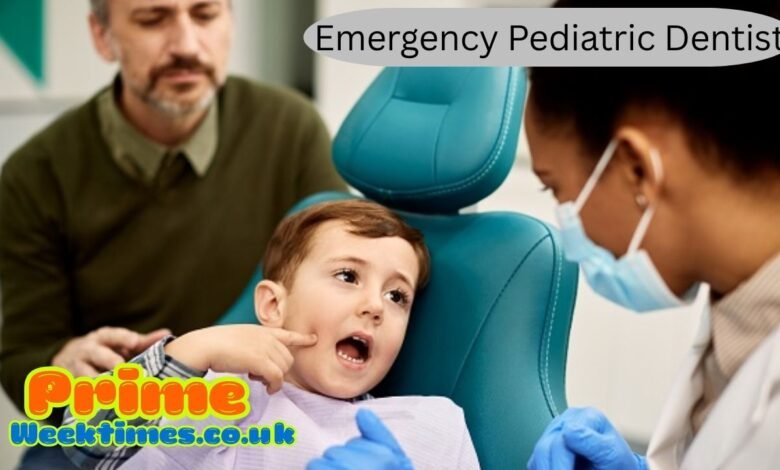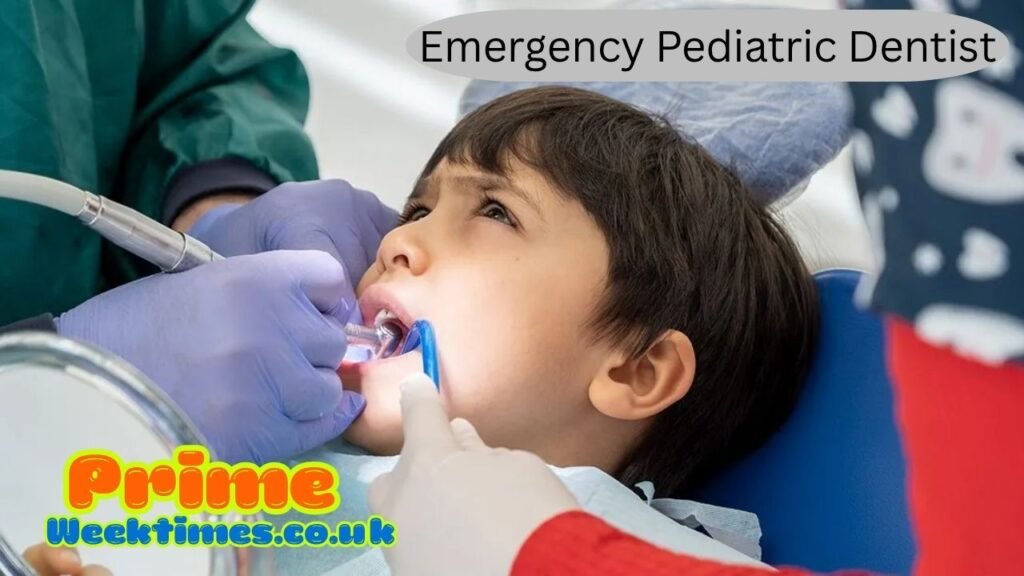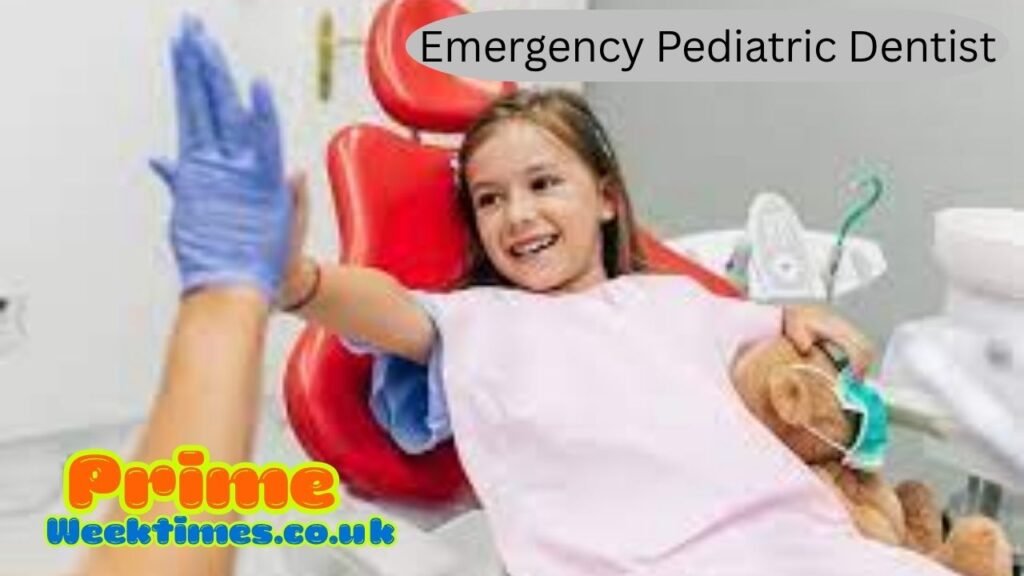Emergency Pediatric Dentist – Ensuring Fast, Compassionate Dental Care for Children in Urgent Situations

Introduction to Emergency Pediatric Dentistry
Every parent dreads the moment their child experiences sudden pain or trauma to their teeth. Whether it’s a broken tooth during playtime, a severe toothache at night, or an unexpected oral injury, knowing where to find an emergency pediatric dentist can make all the difference. Pediatric dental emergencies require quick and specialized care because children’s teeth, gums, and jaws are still developing, and prompt treatment helps prevent long-term complications.
An emergency pediatric dentist is a professional who specializes in managing urgent dental issues in children, from toddlers to teenagers. These dentists are trained not only in handling dental trauma but also in easing a child’s fear and anxiety during the process. They understand that emergencies can be distressing for both kids and parents, which is why their approach combines medical expertise with compassion, patience, and reassurance.
The importance of timely dental care for children cannot be overstated. Left untreated, even minor oral injuries can lead to infection, misalignment, or permanent tooth damage. Therefore, having access to an experienced emergency pediatric dentist ensures that your child receives the right treatment at the right time.
Understanding the Role of an Emergency Pediatric Dentist
An emergency pediatric dentist is different from a general dentist. While general dentists handle routine checkups and dental cleanings, pediatric specialists undergo additional training focused on child development, behavior management, and pediatric oral trauma. This allows them to treat emergencies while ensuring a positive, calm experience for the child.
Common emergencies handled by an emergency pediatric dentist include severe toothaches, knocked-out teeth, fractured or chipped teeth, dental abscesses, and soft tissue injuries. These issues can occur due to accidents, sports injuries, or underlying infections. Pediatric emergency dental care focuses on immediate pain relief, infection control, and preserving the natural tooth whenever possible.
Additionally, pediatric dental offices are designed to be child-friendly environments. Bright colors, kid-focused decorations, and gentle communication techniques help children stay relaxed even in stressful moments. The emergency pediatric dentist plays a dual role—providing expert treatment and emotional support throughout the visit.

Common Dental Emergencies in Children
Children are naturally active and curious, which increases their risk of dental accidents. Knowing how to recognize common dental emergencies and when to seek help from an emergency pediatric dentist can save valuable time and prevent further harm.
Toothaches and Infections
Toothaches are among the most common reasons for an emergency dental visit. A sudden or persistent toothache may indicate cavities, gum infection, or even damage to the tooth pulp. Parents should avoid giving over-the-counter medication without consulting an emergency pediatric dentist, as only a professional can identify the underlying cause and provide safe treatment.
Knocked-Out (Avulsed) Teeth
If a child knocks out a permanent tooth, immediate action is crucial. The emergency pediatric dentist may be able to reimplant the tooth if treatment occurs within 30–60 minutes. For baby teeth, however, reimplantation is generally not recommended because it could damage the developing permanent tooth beneath.
Chipped or Fractured Teeth
Falls and sports injuries can result in chipped or fractured teeth. Depending on the severity, the emergency pediatric dentist may use bonding, crowns, or fillings to restore the tooth. If the damage exposes the nerve, a root canal treatment designed for children may be necessary to save the tooth.
Soft Tissue Injuries
Lacerations to the lips, tongue, or gums often bleed heavily, causing panic. While minor cuts may heal quickly, deeper wounds require medical attention. An emergency pediatric dentist can stop the bleeding, disinfect the area, and check for damage to the surrounding teeth or bone structure.
Lost or Damaged Dental Restorations
Fillings, crowns, or space maintainers can sometimes become loose or fall out. When this happens, an emergency pediatric dentist should assess the situation promptly to avoid pain, infection, or shifting of adjacent teeth.
The Importance of Immediate Care in Pediatric Dental Emergencies
Timing is critical when it comes to children’s dental emergencies. A few minutes can make the difference between saving and losing a tooth. The quicker parents can reach an emergency pediatric dentist, the higher the chance of a successful outcome.
Delaying treatment can lead to severe pain, infection, or permanent damage to developing teeth. In cases of infection, bacteria can spread rapidly to other areas of the mouth or even the bloodstream, creating life-threatening conditions. Early intervention by an emergency pediatric dentist not only prevents complications but also ensures long-term oral health.
Moreover, immediate care helps alleviate a child’s fear. The calm and reassuring demeanor of an emergency pediatric dentist builds trust and reduces anxiety, which can encourage children to maintain good dental habits as they grow older.
How an Emergency Pediatric Dentist Handles a Child’s Anxiety

Dental emergencies can be frightening for children, especially if they are in pain. An emergency pediatric dentist uses specialized communication and behavioral techniques to help young patients feel safe and comfortable during treatment.
They often use positive reinforcement, distraction, and gentle explanations to guide the child through the procedure. Some pediatric dental clinics also provide sedation options, such as nitrous oxide (laughing gas) or mild sedation, to help children stay calm during more complex treatments.
The goal of an emergency pediatric dentist is not just to fix the problem but to ensure the experience is as trauma-free as possible. Establishing a sense of trust early can make future dental visits smoother and more positive for both the child and parent.
What Parents Should Do During a Dental Emergency
Knowing what to do before reaching an emergency pediatric dentist can significantly impact the outcome of the situation. Here are some practical steps parents can take:
- Stay Calm: Children take emotional cues from their parents. Remaining calm helps reassure them.
- Control Bleeding: Use clean gauze to apply gentle pressure to any bleeding area.
- Preserve Knocked-Out Teeth: If a permanent tooth is knocked out, rinse it gently with milk or saline solution. Do not scrub it. Try to place it back in the socket or store it in milk until you reach the emergency pediatric dentist.
- Avoid Self-Medication: Do not use aspirin or numbing gels on children’s gums unless directed by a professional.
- Contact the Dentist Immediately: Always call your emergency pediatric dentist to explain the situation and get instructions before visiting.
These steps ensure that the emergency pediatric dentist can act swiftly and effectively when you arrive.
Preventing Pediatric Dental Emergencies
While not all accidents can be prevented, there are several ways parents can reduce the risk of dental emergencies. Regular dental checkups, good oral hygiene, and protective gear during sports can help safeguard a child’s teeth.
An emergency pediatric dentist often emphasizes preventive care. Fluoride treatments, dental sealants, and education about proper brushing techniques all contribute to stronger, healthier teeth. Encouraging children to avoid biting on hard objects like ice or pens can also prevent fractures.
Moreover, keeping a dental emergency kit at home—with gauze, a small container, and the contact number of your emergency pediatric dentist—ensures you’re always prepared.
The Difference Between a Regular Pediatric Dentist and an Emergency Pediatric Dentist
While both regular and emergency pediatric dentists specialize in children’s oral health, the key difference lies in availability and urgency. A regular pediatric dentist handles routine care, while an emergency pediatric dentist is available for after-hours or same-day appointments.
They often work in specialized clinics equipped with advanced tools for handling trauma, infections, and urgent restorations. The training of an emergency pediatric dentist also includes handling high-stress scenarios, ensuring that even in crisis situations, care is delivered efficiently and empathetically.
Importance of a Child-Friendly Environment in Emergency Dental Care
Children respond best to environments that make them feel secure. The setting of an emergency pediatric dentist’s office plays a huge role in reducing anxiety. Most clinics are designed with bright colors, cheerful themes, and entertainment options like cartoons or toys to help distract young patients during procedures.
Dentists and their staff also communicate in child-friendly language, explaining treatments in simple terms to build understanding and trust. This emotional comfort helps children recover faster and makes future visits less stressful.
When to Visit an Emergency Pediatric Dentist vs. the ER
Parents often wonder whether to visit an emergency pediatric dentist or take their child to the emergency room. In general, dental-specific issues such as tooth fractures, severe toothaches, or knocked-out teeth should be handled by a pediatric dentist. However, if there is excessive bleeding, broken jaw, or head trauma, the emergency room should be the first stop.
Once the child is stabilized, the emergency pediatric dentist can handle the dental restoration and follow-up care. Understanding this distinction helps parents respond appropriately and ensures that children get the right care without unnecessary delays.
The Role of Technology in Emergency Pediatric Dentistry
Modern technology has significantly improved the effectiveness of pediatric emergency care. Digital X-rays, intraoral cameras, and laser dentistry allow the emergency pediatric dentist to diagnose problems quickly and accurately.
Some advanced clinics use 3D imaging to assess fractures or hidden cavities, minimizing radiation exposure for children. These innovations enhance both safety and treatment outcomes, making emergency visits faster and more efficient.
Technology also plays a role in patient communication. Online booking systems and teleconsultations let parents connect with an emergency pediatric dentist instantly, receiving guidance even before arriving at the clinic.
Cost of Emergency Pediatric Dental Services
The cost of seeing an emergency pediatric dentist varies depending on the type of emergency, the severity of the issue, and location. While emergency visits may cost more than routine checkups, most insurance plans partially cover urgent care, especially when related to injury or infection.
Parents should check with their provider to understand coverage options. Many emergency pediatric dentist offices also offer payment plans to make care accessible without financial strain. Ultimately, timely treatment prevents costlier procedures down the road by addressing issues before they escalate.
Building a Relationship with an Emergency Pediatric Dentist
Establishing a long-term relationship with an emergency pediatric dentist is one of the best things parents can do for their child’s oral health. Regular visits help the dentist become familiar with the child’s medical history and dental needs, allowing for faster and more accurate responses in emergencies.
Trust between the child, parent, and dentist ensures smoother communication during stressful situations. Many families choose to stay with the same emergency pediatric dentist for years, valuing their reliability and expertise.
Future of Emergency Pediatric Dentistry
The future of pediatric dental care looks promising, with advances in technology and a growing focus on prevention. AI-powered diagnostic tools and teledentistry will allow faster response times and personalized care recommendations. The emergency pediatric dentist of the future will combine technology, compassion, and education to ensure every child receives the highest quality of care.
As awareness grows, more clinics are expanding emergency services, offering 24/7 availability and mobile dental units to reach families who need urgent care. This accessibility ensures that no child is left suffering due to lack of immediate dental attention.
Conclusion – The Vital Role of an Emergency Pediatric Dentist in Child Health
An emergency pediatric dentist plays a critical role in protecting children’s oral health and overall well-being. From managing pain to preventing permanent damage, their specialized skills and compassionate approach ensure that children receive the best possible care during urgent situations.
Parents should always keep contact information for their local emergency pediatric dentist handy. In moments of panic or uncertainty, having a trusted professional to call can mean the difference between temporary discomfort and lifelong dental problems.
By blending expertise with empathy, the emergency pediatric dentist not only restores smiles but also builds a foundation for healthy dental habits that last a lifetime.

